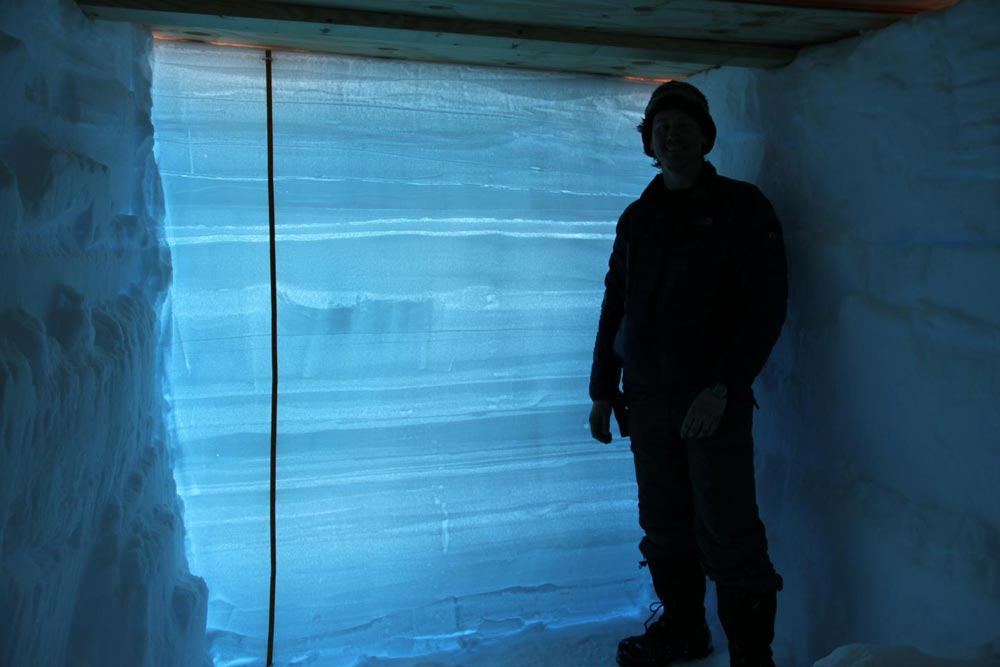

David Noone in a snow pit that reveals layers of snow that pile up one after another as different snow storms pass Summit Station, Greenland. Dark and light layering gives evidence of evaporation and refreezing of water vapor.
Credit: Oregon State University
Researchers found that very little of the snow and ice on the vast interior of the ice sheet is lost to the atmosphere through evaporation because of a strong thermal “lid” that essentially traps the moisture and returns it to the surface where it refreezes.
However, there are signs that this lid is becoming leaky as global temperatures increase. The researchers say there may be a threshold at which warming becomes sufficient to turn on a switch that will destabilize the snow surface.
Results of the study, which was funded by the National Science Foundation, are being published in Science Advances. New measurements from a research tower atop the Greenland ice sheet helped uncovered the mystery of how much snow piles up on this ice sheet.
“Normally, the air temperature goes down as you climb, but near the surface in Greenland, it gets warmer,” said David Noone, an Oregon State University professor who is an atmospheric scientist and principal investigator on the study. “The surface is very cold, but it can be as much as 20 degrees warmer just 30 to 40 feet up in the air. It's enough that you can feel the difference between your nose and your toes.”
“The temperature difference effectively forms a lid so that there is hardly any evaporation. Warm air likes to rise, but if it is already warmer up above the air is trapped nearer the ground. One consequence is that layers of fog form from water that had recently evaporated. Eventually the small fog water-drops drift back down to the very cold surface where it refreezes onto the ice sheet.”
“It's a handy little trick of nature.”
Max Berkelhammer, a researcher at the University of Illinois and lead author on the study, said scientists have been aware of “accumulation zones” in high-altitude areas of the ice sheet, but they haven't been comprehensively measured because of the difficulty in analyzing evaporation and condensation over time.
“Instruments capable of doing this are pretty new and while they have been used before on the ice sheet, they have never been able to run during an entire winter,” said Berkelhammer, who did his post-doctoral work with Noone when both were at the University of Colorado. “I think at this point we are still the only group who has been able to run this type of instrument for an entire year on top of an ice sheet.”
The research aims to better understand how ice cores capture information about past temperatures in Greenland. The snow and ice on Greenland's interior originated from ocean water far to the south and is transported northward by weather systems and storms, and finally falls as snow on the pristine ice sheet.
The researchers are able to track the origins and fate of the water by the ratio of oxygen and hydrogen isotopes in the water.
Variations in the isotope ratios in layers of snow piled up on the ice sheet provide the team a history of Green climate that helps put recent warming into historical context, the researchers say.
To understand past climate, scientists must know how much precipitation fell and how much evaporated. Without the team's analysis, what fraction of falling snow accumulates and what fraction evaporates was difficult to determine. When they began to explore evaporation rates, they discovered this unique thermal lid, which effectively “recycles” water back onto the Greenland Ice Sheet.
This finding will allow previous estimates of Greenland's past water balance to be re-evaluated.
“When thinking about climate change, one often thinks about rising global temperatures,” Noone said. “However in Greenland, as like here in Oregon, climate change is also a story of the changing water cycle and how we lose water because evaporation rates are increasing.
“Climate models suggest that as temperatures increase, more precipitation may actually fall in Greenland because warmer air can hold more water. Taken by itself, that could indicate that parts of the ice sheet may grow. However, if the lid becomes increasingly leaky, the evaporation process has become more effective and moisture will escape to the atmosphere.
“The fate of the ice sheet is in the balance,” Noone said. “It becomes a question of which influence is stronger.”












